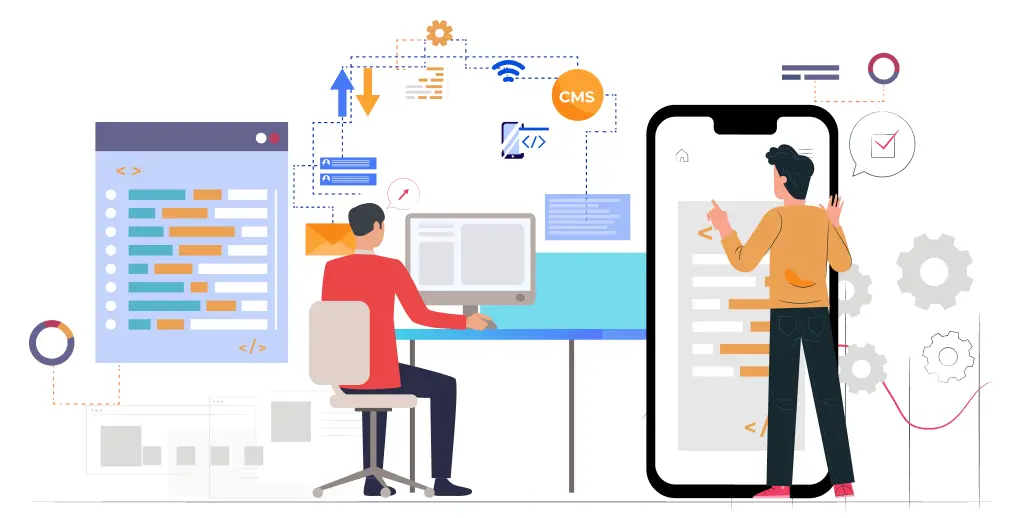Today, digital technologies play a crucial role in the main offerings of organizations – their products.
In the present time, we are in an era where products are developed with a focus on digital expertise.
These products are crafted with a distinct perspective in comparison to conventional product development, even within the realm of information technology.
Video games, email services, design tools, artificial intelligence, voice assistants, and numerous other products and services are not mere appendages to physical goods; rather, they originate within the digital domain.
Are you a burgeoning startup seeking to unveil a novel product or service?
Alternatively, are you an enterprising individual endeavoring to resolve a quandary within your business?
In this article, we shall lead you through each stage of the process for the creation of digital products.

What is a Digital Product?
Digital product development is all about creating a product that people want and enjoy using. It becomes something that occupies their thoughts and they choose it over other options that are available.
In essence, the essence of digital product development revolves around the user. It amalgamates intelligent technology (such as Internet of Things devices), discernment of consumer desires, valuable insights, innovative concepts, and strategic marketing. The objective is to create a product that not only fulfills the customers’ needs but also evolves over time, elevating the user experience to unprecedented levels of satisfaction.
However, how can you develop a digital product?
The process of digital product development is centered on twelve fundamental principles:
1. Research & Preparation
Prior to embarking on the journey of digital product development, it is imperative to thoroughly investigate and ascertain its viability. Employing a problem-solving methodology rooted in product design thinking can assist in selecting the most fitting concept.
2. Ideation
While you may already possess a notion, it is advantageous to employ brainstorming and imaginative contemplation methods to produce an exhaustive compilation of prospective resolutions.
3. Resources
Ensure you possess an ample reservoir of financial assets to bolster the progression of product development, persistently even after the commencement of the product. Crafting a product of worth that yields substantial gains necessitates both time and iterations.
4. Minimum Viable Product
Focus on developing a Minimum Viable Product (MVP) for the initial version. This approach prevents wasting resources on unnecessary features that may become redundant later. Start with something simple and gradually add more features as needed.
Hire an MVP development company now!
5. Sketching & Wireframing
Consider the design of your digital product. If you work with an agency, they can provide specialists to assist you. Alternatively, creating preliminary product designs or wireframes yourself can help others understand your concept and make budgeting easier.
6. Design
Observe and engage with the design of your product on the devices it will be utilized on. This grants you the opportunity to perceive it from the vantage point of the user and implement essential modifications.
7. Prototyping
Before starting the development of the final product, create a scaled-down version of a prototype. This prototype should have the essential functions and integrate well with the rest of your system. Test it with your team and target audience for feedback.
8. Agile Implementation
Using Agile project management techniques can greatly improve development efficiency and ensure a valuable end product. Divide the project into sprints, delivering functioning software after each sprint.
9. Testing & Quality Assurance
Incorporate testing throughout the development process to ensure your digital product performs well and meets expectations. Test it on different devices and address any issues or glitches that arise. Iterate and improve until the product is ready to launch.
10. Launch
Consider conducting a private beta launch before releasing the product to the general audience. This allows you to identify and address any problems or unexpected scenarios that may arise in the initial release. Start cautiously and build a strong foundation for your product.
11. Marketing
Implement your communication and marketing strategy. Use the insights gained from market research to effectively communicate with your target audience and promote your product.
12. Maintenance & Support
While not the most exciting aspect, maintenance and support are crucial for the success of your digital product. Plan and budget for ongoing maintenance to avoid additional costs and prevent post-launch issues that can harm your product’s reputation.
By following these principles, you can enhance the development process and increase the chances of creating a successful digital product.
The Road To Success
By following a well-planned approach to creating digital products, businesses can increase their chances of building a successful product right from the beginning.
To establish a strong presence in the market, companies should adopt these twelve principles for developing digital products.
Should you require any assistance pertaining to the development of digital products, do not hesitate to contact us. We trust that you have found this blog post to be beneficial.
One Reply to “12 Fundamental Principles To Digital Product Development”